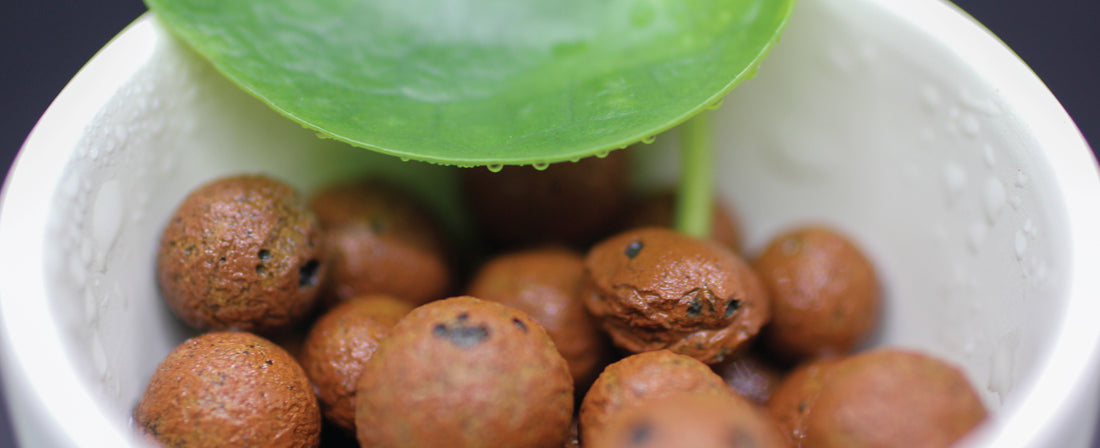
Do you hate getting your hands dirty when mixing or repotting soil? Are you fed up with root diseases and always have problems with overwatering your plants? Then, growing your indoor gardens on soilless media might be the answer.
There are many soilless media in the market today, and the ideal media should have good aeration and drainage for the roots to breathe easily. It is also imperative for the soilless media to be able to hold nutrients so that the roots can easily absorb them. Some common soilless media include perlite, vermiculite, coconut coir, pumice, sawdust, LECA, and rice hulls. Some of these media have unique jobs, like germinating seeds and acting as a rooting medium for cutting, while others are specifically for plant growth.
Of these, LECA is the most popular, especially among indoor plant lovers. But what is LECA, and is it better than soil?
Let’s delve deeper into the world of LECA. In this article we will examine the pros and cons, as well as best practices in fertilizing when using this medium.
What is LECA?
LECA, or Lightweight Expanded Clay Aggregate, consists of little pebble-like clay balls that have been baked in an oven at very high temperatures, causing them to expand and form small, lightweight balls.
These small balls are infused with abundant air pockets, making them porous and an ideal medium with excellent drainage and aeration for growing indoor plants, especially in a semi-hydroponics setting. They come in many sizes ranging from 1-3mm (fine LECA), 4-8 mm (medium LECA), 9-16mm (large LECA), and sometimes even in extra-large sizes (above 17mm).

Should I switch from soil to LECA?
Is LECA better than soil? For sure you have plenty of questions regarding LECA and wondering if it is the right choice for your household plants. Read about the perks and pitfalls of switching from soil to LECA, to know if it's right for you.
Starting the LECA Journey
Transferring your houseplants from soil
One of the most basic methods of using LECA is to use the inner and outer pot method. This setup may sound complicated, but it is actually very simple. All you need is two different pots; an inner pot with drainage holes (to house your plants and the LECA) and an outer pot without drainage holes (to hold the fertilizer solution and act as the reservoir). Once you have the LECA, the pots, and your fertilizer solution, you can then begin the transition by following these simple steps:

Step 1: Removing the soil
This step is very crucial and can take a while. While cleaning the roots, you must be very careful not to damage the roots. You want to altogether remove all soil from the roots before transferring it to LECA. This is to avoid future contaminations or root-related issues.
Step 2: Flushing the LECA
Before using them, make sure to give them a good wash to remove any lingering chemicals and dust. Just pop them in a big container and rinse them under running water while swishing them around. Once you've done that, let them soak in water for at least a day. For even better results, let them soak for three days, changing the water daily. On the last soak, add a nutrient solution like Grow Goodies™ to really get them packed with nutrients for the best start possible. Your plant babies will thank you!
Step 3: Transplanting in LECA
Are we finally there? Yes, you've made it! Once your LECA is squeaky clean, it's time for the big move. Start by adding LECA to the inner pot, filling it up about one-third of the way. Next, it's time to give your houseplant a new home. Nestle it on top of the LECA base layer and cover the roots with more of the clay balls. Make sure all the roots are snug as a bug in a rug. Finally, place the inner pot into the outer pot, sit back and admire your green thumb skills.
Step 4: Making your nutrient solution and fertilizing your plant
This is the most important step as it involves the part of taking care of your plants. The rule of thumb is to make sure you use the correct fertilizer as it will save you a lot of disappointment and heartache later. You should not use general fertilizers as they do not contain the complete set of nutrients needed for your plant—further, they may not support the correct pH level for your plant.
Spilling the tea on fertilizers... A fertilizer/plant food that contains only nitrogen, potassium, and phosphorus will not be enough for the long term nutrition of any plant. These types of fertilizers are very common. These products usually come in liquid or tablet form and may be relatively inexpensive. In fact, many of them only contain 3% nitrogen, 1% phosphorus, and 2% potassium. While the 3-1-2 NPK ratio is very good for Ficus and other houseplants, this low concentration of macro nutrients is not enough for long term plant health.
So, what's the skinny on fertilizer? When it comes to your beloved leafy friends, you don't want to skimp on the good stuff. Bless Your Soil® has got your back with not one, not two, but three amazing concoctions to nourish your plants to the max. Think complete spectrum of nutrients, with a splash of seaweed extract for good measure. Check out the chart below to figure out which mix is the perfect match for your little green beauties. They'll be thriving in no time!
Which Fertilizer for Which Plant?
Use the chart below for perfecting your nutrient solution. Read more about Fertilizing Plants in LECA & Soilless Media:
| Ficus varieties | Leafy and Tropical Houseplants | Blooming Plants (Orchids*) | |
| Fertilizer | Fiddle-Leaf Treats™ | Big Green Leaves™ |
Big Green Leaves™ (while plant is in flower stage) Grow Goodies™ (pre-bloom/budding stage) |
| Dosage | 1¼ tsp per gallon of water | 1½ tsp per gallon of water |
Big Green Leaves: 1½ tsp per gallon of water Grow Goodies: ¾ tsp per gallon of water *For orchids, cut these ratios in half to a third the recommended amount for constant feeding |
Show Those Orchids Who's Boss
While in bloom: Get a gallon of distilled water and dissolve 1/3 tsp of Big Green Leaves in the jug. Use this nutrient solution to keep your orchid's LECA reservoir at approximately 1/4 the height of the container.
Pre-bloom: Dissolve 1/4 tsp of Grow Goodies in a gallon of distilled water. Use this nutrient solution in your orchid's LECA reservoir and spritz roots and leaves once or twice per week. Add an ice cube or two one night per week. Not only will it cool things down, but it'll also coax those flower spikes into action. And once those spikes start sprouting, hold off on the fertilizer.
Read: Fertilizing Plants in LECA & Soilless Media: How Much and When?
Step 5: Flushing the pot
After about 4 weeks, depending on the type of water you use, you may notice salt residue accumulating on the LECA, indicating that it’s time to flush the LECA. When flushing, hold the inner pot under running water so that all the salts are flushed out from the LECA. At this juncture, it’s also the best time to replace the nutrient solution.
Safeguarding against pH changes
Don't let your plants suffer from pH dysfunction. The good news is that our organically bonded minerals give you a bit more leeway when it comes of pH, but they can still be a bit picky! Keep an eye on that pH level when growing in LECA, or your plants might just decide to stop absorbing nutrients altogether. Trust us, you don't want hangry plants on your hands! Learn more about the crucial role of pH in plant growth and keep your green buddies happy and thriving.
Read more information about the importance of pH and its impact on houseplants.
Is LECA appropriate for Ficus varieties?
Why LECA and Ficus are a Match Made in Heaven
Ficus lovers, rejoice! Growing your favorite varieties in LECA can be a game-changer. Fiddle-Leaf Fig Tree, Ficus audrey, Ficus elastica, bonsai Ficus microcarpa, Ficus altissima, and more have all thrived in LECA. And let's be honest, Ficus can be a bit of a diva when it comes to water - too much or too little, and it's game over. But with LECA, you have a growth medium that keeps your plants from drowning or getting thirsty. Plus, Ficus roots and clay balls? They're like two peas in a pod.
Pro Tip for Ficus in LECA
P.S. Don't try to transition your Ficus to LECA in the winter, it's a real downer as Ficus generally remains dormant during winter. It’s best to carry out the switch during spring or summer. Ficus is also very susceptible to environmental changes and takes time to acclimatize. So, after the switch from the soil, it is best to place Ficus in LECA with only water (1/3 the height of the outer pot). The nutrient solution can be added after a week or so to help with the acclimatization process.
Which fertilizer should I use when my Ficus is in LECA?
Fiddle-Leaf Treats™ is a recipe formulated specifically for Ficus varieties. It contains a broad spectrum of nutrients as well as trace elements and organic materials that Ficus plants grow crazy good for. And, did we mention it contains botanical sea kelp? in short, it's works like amaze-balls in your clay-balls.
Reap the LECA Benefits
Growing in LECA is a great way to ensure the health and wellbeing of a variety of plants. It's important to pay attention to the pH of the nutrient solution, as well as avoiding transitioning during winter time when they are dormant. Bless Your Soil® provides an excellent source of macro-nutrients and trace elements that will help your leafy friends flourish in their new environment. With these tips, you’ll be able to get the most out of growing with LECA!
So take care of those leafy greens and enjoy watching them grow!
Browse our shop for fertilizers
Related articles in this thread:
|
To LECA or not to LECA? Pros and Cons to Consider for Your Plants
|
Fertilizing Plants in LECA & Soilless Media: How Much and When? |
Don't Be Basic - Get pH Balanced: The Ultimate Guide to Plant Care |








